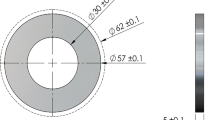Abstract
Minimum quantity of lubricant (MQL) in grinding is an alternative for reducing abundant fluid flow and both environmental and health hazards when compared with conventional fluid application. In spite of the fact that MQL is considered an innovative cost-effective and environmentally friendly technique, when used in grinding its inadequate application can increase cutting temperature and wheel clogging, worsening surface roughness, and increasing geometric and dimensional errors. The present study aims to evaluate improvements in MQL in grinding using MQL + water (1:1, 1:3, and 1:5 parts of oil per parts of water), when compared to MQL without water and conventional cooling-lubrication technique. Wheel cleaning by compressed air was also tested, aimed for unclogging of the wheel pores. The tests were performed in a plunge cylindrical grinder with CBN wheel and workpieces of AISI 4340 for different feed rates. The ground workpieces were analyzed with respect to the surface roughness, roundness errors, microhardness, and microscopic changes. In addition, tangential cutting force and diametric wheel wear were investigated. The results observed for the MQL plus water in the proportion of 1:5, with wheel cleaning system (at 30° inclination angle of the air nozzle) were the best, when compared to MQL without water, and close to the conventional flood coolant, implying that this technique is a potential alternative for cooling-lubrication when applied properly.
Similar content being viewed by others
References
Tawakoli T, Hadad MJ, Sadeghi MH et al (2009) An experimental investigation of the effects of workpiece and grinding parameters on minimum quantity lubrication-MQL grinding. Int J Mach Tools Manuf 49:924–932. doi:10.1016/j.ijmachtools.2009.06.015
Sharma VS, Singh G, Sørby K (2014) A review on minimum quantity lubrication for machining processes. Mater Manuf Process 30:935–953. doi:10.1080/10426914.2014.994759
Hryniewicz P, Szeri AZ, Jahanmir S (2000) Coolant flow in surface grinding with non-porous wheels. Int J Mech Sci 42:2347–2367. doi:10.1016/S0020-7403(99)00084-3
Malkin S, Guo C (2008) Grinding technology: theory and application of machining with abrasives, 2nd edn. Industrial Press, New York
Winter M, Bock R, Herrmann C (2013) Investigation of a new polymer-water based cutting fluid to substitute mineral oil based fluids in grinding processes. CIRP J Manuf Sci Technol 6:254–262. doi:10.1016/j.cirpj.2013.07.003
Ebbrell S, Woolley NH, Tridimas YD et al (2000) The effects of cutting fluid application methods on the grinding process. Int J Mach Tools Manuf 40:209–223. doi:10.1016/S0890-6955(99)00060-7
Tawakoli T, Hadad M, Sadeghi MH et al (2011) Minimum quantity lubrication in grinding: effects of abrasive and coolant-lubricant types. J Clean Prod 19:2088–2099. doi:10.1016/j.jclepro.2011.06.020
Sadeghi MH, Haddad J, Tawakoli T, Emami M (2009) Minimal quantity lubrication-MQL in grinding of Ti-6Al-4V titanium alloy. Int J Adv Manuf Technol 44:487–500. doi:10.1007/s00170-008-1857-y
Di Ilio A, Paoletti A (2000) Comparison between conventional abrasives and superabrasives in grinding of SiC-aluminium composites. Int J Mach Tools Manuf 40:173–184. doi:10.1016/S0890-6955(99)00061-9
Belentani RDM, Funes Júnior H, Canarim RC et al (2014) Utilization of minimum quantity lubrication (MQL) with water in CBN grinding of steel. Mater Res 17:88–96. doi:10.1590/S1516-14392013005000165
Nascimento WR, Yamamoto AA, Mello HJ et al (2015) A study on the viability of minimum quantity lubrication with water in grinding of ceramics using a hybrid-bonded diamond wheel. Proc Inst Mech Eng Part B J Eng Manuf 1–9. doi:10.1177/0954405415579016
Mao C, Tang X, Zou H et al (2011) Experimental investigation of surface quality for minimum quantity oil-water lubrication grinding. Int J Adv Manuf Technol 59:93–100. doi:10.1007/s00170-011-3491-3
Oliveira DDJ, Guermandi LG, Bianchi EC et al (2012) Improving minimum quantity lubrication in CBN grinding using compressed air wheel cleaning. J Mater Process Technol 212:2559–2568. doi:10.1016/j.jmatprotec.2012.05.019
Marinescu ID, Rowe WB, Dimitrov B, Inasaki I (2004) Tribology of abrasive machining processes, 1st edn. William Andrew, Inc., Norwich
Silva LR, Bianchi EC, Fusse RY et al (2007) Analysis of surface integrity for minimum quantity lubricant-MQL in grinding. Int J Mach Tools Manuf 47:412–418. doi:10.1016/j.ijmachtools.2006.03.015
Silva LR, Corrêa ECS, Brandão JR, De Ávila RF (2013) Environmentally friendly manufacturing: behavior analysis of minimum quantity of lubricant—MQL in grinding process. J Clean Prod. doi:10.1016/j.jclepro.2013.01.033
Sohal N, Sandhu CS, Panda BK (2014) Analyzing the effect of grinding parameters on MRR and surface roughness of EN24 and EN353 steel. Mech Confab 3:1–6
Brinksmeier E, Heinzel C, Wittmann M (1999) Friction, cooling and lubrication in grinding. CIRP Ann Manuf Technol 48:581–598. doi:10.1016/S0007-8506(07)63236-3
Shaw MC (1996) Energy conversion in cutting and grinding*. CIRP Ann Manuf Technol 45:101–104. doi:10.1016/S0007-8506(07)63025-X
Tawakoli T, Westkämper E, Rabiey M, Rasifard A (2007) Influence of the type of coolant lubricant in grinding with CBN tools. Int J Mach Tools Manuf 47:734–739. doi:10.1016/j.ijmachtools.2006.09.010
Wang Y, Li C, Zhang Y et al (2016) Experimental evaluation of the lubrication properties of the wheel/workpiece interface in MQL grinding using different types of vegetable oils. J Clean Prod. doi:10.1016/j.jclepro.2016.03.121
Silva LR, Bianchi EC, Catai RE et al (2005) Study on the behavior of the minimum quantity lubricant—MQL technique under different lubricating and cooling conditions when grinding ABNT 4340 steel. J Braz Soc Mech Sci Eng 27:192–199. doi:10.1590/S1678-58782005000200012
Author information
Authors and Affiliations
Corresponding author
Rights and permissions
About this article
Cite this article
Ruzzi, R.d., Belentani, R.d., de Mello, H.J. et al. MQL with water in cylindrical plunge grinding of hardened steels using CBN wheels, with and without wheel cleaning by compressed air. Int J Adv Manuf Technol 90, 329–338 (2017). https://doi.org/10.1007/s00170-016-9396-4
Received:
Accepted:
Published:
Issue Date:
DOI: https://doi.org/10.1007/s00170-016-9396-4



